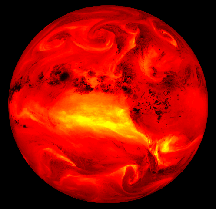|
 In 2000, Haywood County, NC experienced its 4th highest 8-hour ozone concentration at 0.085 ppm. On May 1, a daily maximum 8-hour average concentration of 0.089 ppm was experienced. A detailed meteorological analysis suggests that stratospheric ozone played an important role in this ozone episode. Please visit our web site for more information. |
 Chemical transport models underestimate background ozone concentrations at both low - and high-elevation monitoring sites. Many of the models cannot adequately quantify the natural contribution of stratospheric ozone to surface ozone concentrations. Background ozone is important because it contributes an important amount of ozone to measured surface concentrations at many locations across the U.S. Learn more about background ozone by clicking here. |
 Can we attain an 8-hour ozone standard as lower levels are established? Find out by learning more about the "Piston Effect" by clicking here. |
 Over the years, the EPA has been concerned about the uncertainties associated with epidemiological results. Some of these uncertainties are (1) confirming which co-pollutants were responsible for the health effects observed, (2) explaining the heterogeneity in effect estimates between locations, (3) quantiying the potential for exposure measurement errors, and (4) the interpretation of the shape of concentration-response functions for ozone concentrations in the lower portions of ambient distributions. Some background information on these concerns is available by clicking here. |
 As of December 31, 2025, EPA indicated there are 45 ozone (8-hour 2015 standard), 34 ozone (8-hour 2008 standard), 5 PM-2.5 (2012 Standard), 8 PM-2.5 (2006 standard), 21 PM-10 (1987 standard), 26 sulfur dioxide (2010 standard), 7 sulfur dioxide (1971 standard), 10 lead (2008 standard), 1 lead (1978 standard), 0 carbon monoxide, and 0 NO2 nonattainment areas in the United States. Maps are available for your review and download by clicking here. |
 Beginning in September 1994, under a grant from the U.S. Department of Energy, A.S.L. & Associates and its subcontractor, CAPITA at Washington University St. Louis, and consultant Dr. Peter Brimblecombe combined talents to develop a database that allows for the estimation of the global emissions of sulfur from 1850 to 1990. A common methodology was applied across all years and countries for the estimation of sulfur emissions. Please visit our web page for more information. |
|
 Concerns about attaining the 8-hour ozone standard because of the "piston" effect appear to be realistic based upon EPA's latest trends report. |
 EPA has summarized ozone trends for the periods 1980-2023, 1990-2023, 2000-2023, and 2010-2023. EPA notes that levels are still decreasing nationwide, but the rate of decrease for 8-hour levels has slowed down. However, in several regions of the U.S., ozone trends are increasing. Please click here for more information. |
 Biological evidence developed under both experimental and actual ambient conditions indicate that, in general, the higher hourly average concentrations are potentially more important than the mid- and low-level hourly average concentrations in eliciting an adverse effect on vegetation. When considering flux-based ozone modelling results, defense mechanisms, which vary over a 24-h period, are important when describing the relationship between exposure, dose, vegetation effects, and the ozone standard-setting process. Please visit our web page for more information. |
 In March 2008, the EPA Administrator lowered the 8-hour human health and vegetation ozone standards to 0.075 ppm. On September 16, 2009, the EPA announced that it was reviewing the March 2008 decision. On October 1, 2015, the EPA set new 8-hour standards at 0.070 ppm. Since 2015, EPA has contined to evaluate the scientific evidence for lowering the U.S. ozone standard. Please click here for additional information. |
 The W126 Exposure Index The EPA is using the W126 cumulative exposure index as an indicator to use to protect vegetation. The index has been proposed several times as a standard to protect vegetation. Dr. Lefohn, President of A.S.L. & Associates, developed and proposed this index in 1985 as a way to protect vegetation from ozone exposures. Learn more about the W126 exposure index. |
A.S.L. & Associates, LLC
P.O. Box 196
Clancy, Montana 59634
asl@asl-associates.com
|